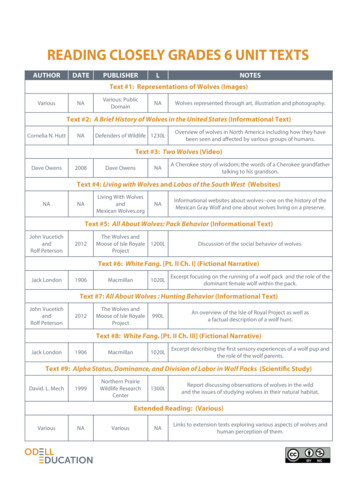
Transcription
READING CLOSELY GRADES 6 UNIT TEXTSAUTHORDATEPUBLISHERLNOTESText #1: Representations of Wolves (Images)VariousVarious: PublicDomainNANAWolves represented through art, illustration and photography.Text #2: A Brief History of Wolves in the United States (Informational Text)Cornelia N. HuttNADefenders of Wildlife 1230LOverview of wolves in North America including how they havebeen seen and affected by various groups of humans.Text #3: Two Wolves (Video)Dave Owens2008Dave OwensNAA Cherokee story of wisdom; the words of a Cherokee grandfathertalking to his grandson.Text #4: Living with Wolves and Lobos of the South West (Websites)NALiving With WolvesandMexican Wolves.orgNANAInformational websites about wolves--one on the history of theMexican Gray Wolf and one about wolves living on a preserve.Text #5: All About Wolves: Pack Behavior (Informational Text)John VucetichandRolf Peterson2012The Wolves andMoose of Isle Royale 1200LProjectDiscussion of the social behavior of wolves.Text #6: White Fang. [Pt. II Ch. I] (Fictional Narrative)Jack London1906Macmillan1020LExcerpt focusing on the running of a wolf pack and the role of thedominant female wolf within the pack.Text #7: All About Wolves : Hunting Behavior (Informational Text)John VucetichandRolf Peterson2012The Wolves andMoose of Isle RoyaleProject990LAn overview of the Isle of Royal Project as well asa factual description of a wolf hunt.Text #8: White Fang. [Pt. II Ch. III] (Fictional Narrative)Jack London1906Macmillan1020LExcerpt describing the first sensory experiences of a wolf pup andthe role of the wolf parents.Text #9: Alpha Status, Dominance, and Division of Labor in Wolf Packs (Scientific Study)David. L. Mech1999Northern PrairieWildlife ResearchCenter1300LReport discussing observations of wolves in the wildand the issues of studying wolves in their natural habitat.Extended Reading: (Various)VariousNAOD LLDUCATIONVariousNALinks to extension texts exploring various aspects of wolves andhuman perception of them.Page 1
A-GC.com. Public DomainTEXT #1 Emil Doepler. Public 22233/-Odin at RagnarokEmil at-ragnarok.htmlPage 2
Doug Smith. Public DomainMollies Pack Wolves Baiting a BisonDoug Smith Public lf pack surrounding bison usps.jpgRoping Gray Wolfhttp://www.thepublicdomain.net/2008 01 01 archive.htmlPage 3
Gustave Dore. Public DomainRed Riding Hood meets old Father WolfGustave ed-riding-hood-meets-old-father-wolfPage 4
TEXT #2A Brief History of Wolves in the United StatesCornelia N. HuttDefenders of Wildlifehttp://kidsplanet.org/www/index.htmlWolves once roamed across most of North America. Over hundreds of thousands ofP1years they developed side by side with their prey and filled an important role in the webof life. Opportunistic hunters, wolves preyed on deer, elk and beaver, killing and eatingthe young, the sick, the weak and the old and leaving the fittest to survive and reproduce.5 Wolf kills provided a source of food for numerous other species such as bears, foxes,eagles and ravens. Wolves even contributed to forest health by keeping deer and elkpopulations in check, thus preventing overgrazing and soil erosion.P2Not surprisingly, the cultures which inhabited North America before the time ofEuropean exploration revered the wolf and its role in nature. Many indigenous groups10 relied on hunting as their major source of food and goods and were keenly attuned totheir environment. The elements of the natural world, including the wolf, were importantto their everyday lives and spirituality.Native Americans attributed an array of powers and miracles to wolves, from theP3preyopportunisticspeciesan animal hunted for foodtaking advantage of a situationa biological classificationbelonging to the same groupreveredindigenousattunedhonored, adored, respectedcoming from a particular region orcountryaware, in harmonyattributedarrayassigned, associateda large group or numberPage 5
creation of tribes to healing powers. For example, the Kwakiutl of the Pacific Northwest15 believed that before they became men or women, they had been wolves. The Arikarabelieved that Wolf-Man made the Great Plains for them and the other animals. The Siouxand Cheyenne of the Great Plains and many other tribes credited the wolf with teachingthem how to survive by hunting and by valuing family bonds.In other Native American cultures, the wolf played an important role in the spiritualP420 and ceremonial life of the tribe. Wolves were regarded as mysterious beings with powersthey could bestow upon people. The Crow, for instance, believed that a wolf skin couldsave lives. Other Native American lore is full of stories of wolves and of wolf parts healingthe sick and the mortally injured.P5When Europeans arrived in the New World, roughly 250,000 wolves flourished in25 what are now the lower 48 states. Many settlers, however, brought with them a legacy ofpersecution dating back centuries. Mythology, legends and fables such as thosepopularized by Aesop and the Brothers Grimm intensified people’s fear of wolves. InAmerica, the killing of wolves came to symbolize the triumph of civilization over what wasconsidered to be a wilderness wasteland. In 1630, just ten years after the Mayflower landed30 at Plymouth Rock, the Massachusetts Bay Colony began offering a reward (bounty) forevery wolf killed.spiritualceremonialbestowbeliefs and valuesrelating to ritualsto give as a giftloremortallylegacytraditional wise teachings orstoriesending in or causing deathsomething handed down from thepastpersecutionintensifiedhurting or causing trouble tosomeone who is weaker ordifferentstrengthened or deepenedPage 6
Colonists relied heavily on the deer population for food for themselves and as anP6export item. When the deer population dropped as a result of over-hunting, wolvesbecame a convenient scapegoat. They were also held accountable for livestock losses,35 even when diseases and other causes were to blame. Few people seemed to question thebelief that a safe home required the elimination of all the wolves.In time, wolf killing became a profession. In the 19th century, the demand for peltsP7sent hundreds of hunters out to kill every wolf that they could. At the same time, ranchersmoved into the western plains to take advantage of cheap and abundant grazing land. As40 domestic livestock replaced the wolf’s natural prey base of bison and deer, the threat ofwolf predation on cattle led to a massive campaign to exterminate the wolf in theAmerican west. Professional “wolfers” working for the livestock industry laid out strychnine-poisoned meat lines up to 150 miles long. When populations dropped to such low levelsthat wolves were difficult to find, states offered bounties with the goal of extirpating45 wolves altogether. Wolves were shot, poisoned, trapped, clubbed, set on fire andinoculated with mange, a painful and often fatal skin disease caused by mites. In a 25-yearperiod at the turn of the century, more than 80,000 wolves were killed in Montana alone.Well into the 20th century, the belief that wolves posed a threat to human safetyP8persisted despite documentation to the contrary. The QFSTFDVUJPO continued. By the50 1970s, only 500 to 1,000 wolves remained in the lower 48 states, occupying less than threepercent of their former range.scapegoatpeltsdomestic livestocka person or group made to takethe blame or to suffer in place ofsomeone elsefur and skinfarm animals that are raised locallyand are bred to be dependent onhumans (eg. chickens and cows)predationextirpatingthe relationship between animalswhere one hunts and feeds on theotherremoving or destroying totallyPage 7
Fortunately, America’s understanding of the wolf has grown in the last 20 years. AsP9scientists have discovered more about the intricacies of nature, our knowledge of theinterdependence of all living things has increased significantly. People are now more55 aware of the importance of predators in maintaining healthy ecosystems. In addition, asour population has become increasingly urbanized and wilderness areas have beenswallowed up by development, we have begun to treasure what we are losing. The wolfhas become a symbol of our loss. The overwhelming number of wolf advocacy groupsthat now thrive in the United States attest to the degree to which these predators have60 captured our interest and our imagination.Thanks to efforts by the U.S. Fish and Wildlife Service, zoos and wildlife advocacyP10groups, wolves have slowly begun to recover in areas where they have long been absent.In recent years, wolves have been successfully reintroduced to former habitats in centralIdaho, Wyoming, Montana, North Carolina and Arizona. More than 5,000 wolves now65 inhabit the wild south of Canada. While many welcome this recovery, a vocal minorityremains strongly opposed to the presence of any wolves at all in the wild.intricaciespredatorsurbanizedcomplex aspectsan animal that eats other animalsmade part of a cityadvocacyhabitatssupportthe natural environment; place thatis natural for the life of an animalPage 8
TEXT #3TWO WOLVESDavid Owenshttp://www.youtube.com/watch?feature player embedded&v E8CHjX8HauA#!TEXT #4Living With WolvesJim and Jamie DutcherLiving With obos of the South WestMexican bout-wolvesPage 9
TEXT #5All About WolvesJohn Vucetich and Rolf PetersonWolves and Moose of Isle Royale Project, lves.htmlPACK BEHAVIORAbout The Wolves and Moose of Isle Royale Project: OverviewP1Isle Royale is a remote wilderness island, isolated by the frigid waters of LakeSuperior, and home to populations of wolves and moose. As predator and prey, their livesand deaths are linked in a drama that is timeless and historic. Their lives are historic5 because we have been documenting their lives for more than five decades. This researchproject is the longest continuous study of any predator-prey system in the world.Observations of Pack BehaviorWolves develop from pups at an incredible rate. Pups are born, in late April, after justP2a two-month pregnancy. They are born deaf, blind, and weigh no more than a can of soda10 pop. At this time, pups can do basically just one thing – suckle their mother’s milk.P3Within a month, pups can hear and see, weigh ten pounds, and explore and playaround the den site. The parents and sometimes one- or two- year old siblings bring foodback to the den site. The food is regurgitated for the pups to eat. By about two months ofage (late June), pups are fully weaned and eat only meat. By three months of age (lateisolatedsuckleregurgitatedseparated from other persons orthingsto suck at the breast or udderundigested food that is vomitedsiblingsbrothers or sistersPage 10
15 July), pups travel as much as a few miles to rendezvous sites, where pups wait for adultsto return from hunts.Pups surviving to six or seven months of age (late September) have adult teeth, areP4eighty percent their full size, and travel with the pack for many miles as they hunt andpatrol their territory. When food is plentiful, most pups survive to their first birthday. As20 often, food is scarce and no pups survive.P5A wolf may disperse from its natal pack when it is as young as 12 months old. Insome cases a wolf might disperse and breed when it is 22 months old – the secondFebruary of its life. In any event, from 12 months of age onward, wolves look for a chanceto disperse and mate with a wolf from another pack. In the meantime, they bide their time in25 the safety of their natal pack.From birth until his or her last dying day, a wolf is inextricably linked to other wolvesP6in a complex web of social relationships. The ultimate basis for these relationships issharing food with some, depriving it from others, reproducing with another, andsuppressing reproduction among others.30 Most wolves live in packs, a community sharing daily life with three to eleven otherP7wolves. Core pack members are an alpha pair and their pups. Other members commonlyinclude offspring from previous years, and occasionally other less closely related wolves.rendezvousdispersenatala place that is popular to meet orgatherto separate, to move awayrelating to birthinextricablycomplexalphacompletely involved in somethinga very complicated arrangementan animal having the highest rankin its groupoffspringchildren or young of a certainparentPage 11
P8Pups depend on food from their parents. Relationships among older, physicallymature offspring are fundamentally tense. These wolves want to mate, but alphas repress35 any attempts to mate. So, mating typically requires leaving the pack. However, dispersalis dangerous. While biding time for a good opportunity to disperse, these subordinatewolves want the safety and food that come from pack living. They are sometimes toleratedby the alpha wolves, to varying degrees. The degree of tolerance depends on the degreeof obedience and submission to the will of alpha wolves. For a subordinate wolf, the40 choice, typically, is to acquiesce or leave the pack.Alphas lead travels and hunts. They feed first, and they exclude from feeding whomP9ever they choose. Maintaining alpha status requires controlling the behavior of packmates. Occasionally a subordinate wolf is strong enough to take over the alpha position.Wolf families have and know about their neighbors. Alphas exclude non-packP1045 members from their territory, and try to kill trespassers. Mature, subordinate packmembers are sometimes less hostile to outside wolves – they are potential mates.Being an alpha wolf requires aggression, control, and leadership. Perhaps notP11surprisingly, alpha wolves typically possess higher levels of stress hormones than dosubordinate wolves, who may not eat as much, but have, apparently, far less stress.materepressdispersalto reproduceto keep down, to stopthe act of dispersing, separating,moving awaysubordinatetoleranceacquiescebelonging to a lower rankacceptance, patient attitudeto accept something without anyprotestexcludestatuspotentialto keep outthe position of an individual inrelation to other in the grouppossiblePage 12
50 Pack members are usually, but not always friendly and cooperative. Wolves fromP12other packs are usually, but not always enemies. Managing all of these relationships, in away that minimizes the risk of injury and death to one’s self, requires sophisticatedcommunication. Accurately interpreting and judging these communications requiresintelligence. Communication and intelligence are needed to know who my friends and55 enemies are, where they are, and what may be their intentions. These may be the reasonsthat most social animals, including humans, are intelligent and communicative.Like humans, wolves communicate with voices. Pack mates often separateP13temporarily. When they want to rejoin they often howl. They say: “Hey, where are youguys? I’m over here.” Wolf packs also howl to tell other packs: “Hey, we are over here; stay60 away from us, or else.”There is so much more to wolf communication. Scientists recognize at least tenP14different categories of sound (e.g., howls, growls, barks, etc.). Each is believed tocommunicate a different, context-dependent message. Wolves also have an elaboratebody language. As subtle as body language can be, even scientists recognize65 communication to be taking place by the positions of about fifteen different body parts(e.g., ears, tail, teeth, etc.). Each body part can hold one of several positions (e.g., tail up,out, down, etc.). There could easily be hundreds to thousands of different messagescommunicated by different combinations of these body positions and vocal noises.Scientists apprehend (or misapprehend) just a fraction of what wolves are able to70 communicate to each other.sophisticatedintentionssubtlecomplex or complicatedpurposes or goalsnot obvious, can be difficult tounderstand or seeapprehendto understand the meaning ofsomethingPage 13
Wolves also communicate with scent. The most distinctive use of scent entailsP15territorial scent marking.Elusiveness makes wolves mysterious. This is true and fine. However, true loveP16cannot survive mystery due to ignorance. Mature love requires knowledge. In some75 basic ways the life of a wolf is very ordinary, even mundane, and its comprehension is fullywithin our grasp if we just focus.The life of a wolf is largely occupied with walking. Wolves are tremendous walkers.P17Day after day, wolves commonly walk for eight hours a day, averaging five miles per hour.They commonly travel thirty miles a day, and may walk 4,000 miles a year.80 Wolves living in packs walk for two basic reasons - to capture food and to defendP18their territories. Isle Royale wolf territories average about 75 square miles. This is smallcompared to some wolf populations, where territories can be as large as 500 square miles.To patrol and defend even a small territory, involves a never-ending amount of walking.Week after week, wolves cover the same trails. It must seem very ordinary.85 The average North American human walks two to three miles per day. A fit humanP19walks at least five miles/day. If you want to know more about the life of a wolf, spendmore time just walking, and while walking, know that you are walking. What do wolvesthink about much while walking?elusivenessmundanethe quality of being difficult to seedullPage 14
Wolves defend territories. About once a week, wolves patrol most of their territorialP2090 boundary. About every two to three hundred yards along the territorial boundary an alphawolf will scent mark, that is, urinate or defecate in a conspicuous location. The odor fromthis mark is detectable, even to a human nose, a week or two after being deposited. Themark communicates to potential trespassing wolves that this area is defended. Territorialdefense is a matter of life and death. Intruding wolves, if detected, are chased off or killed,95 if possible.Wolves are like humans for having such complex family relationships. Wolves areP21also like some humans in that they wage complete warfare toward their neighbors.An alpha wolf typically kills one to three wolves in his or her lifetime.Page 15
TEXT #6White FangJack LondonMacmillan, .htmExcerpt: Pt. II, C.h. ITHE BATTLE OF THE FANGSIt was the she-wolf who had first caught the sound of men’s voices and the whiningP1of the sled-dogs; and it was the she-wolf who was first to spring away from the corneredman in his circle of dying flame. The pack had been loath to forego the kill it had hunteddown, and it lingered for several minutes, making sure of the sounds, and then it, too,5 sprang away on the trail made by the she-wolf.P2Running at the forefront of the pack was a large grey wolf—one of its severalleaders. It was he who directed the pack’s course on the heels of the she-wolf. It was hewho snarled warningly at the younger members of the pack or slashed at them with hisfangs when they ambitiously tried to pass him. And it was he who increased the pace10 when he sighted the she-wolf, now trotting slowly across the snow.P3She dropped in alongside by him, as though it were her appointed position, andtook the pace of the pack. He did not snarl at her, nor show his teeth, when any leap ofhers chanced to put her in advance of him. On the contrary, he seemed kindly disposedloathforegoambitiouslyreluctantto leave without finishingeagerly, with effortappointeddisposednominated, selected, givenwilling, showing good temperPage 16
toward her—too kindly to suit her, for he was prone to run near to her, and when he ran15 too near it was she who snarled and showed her teeth. Nor was she above slashing hisshoulder sharply on occasion. At such times he betrayed no anger. He merely sprang tothe side and ran stiffly ahead for several awkward leaps, in carriage and conductresembling an abashed country swain.This was his one trouble in the running of the pack; but she had other troubles. OnP420 her other side ran a gaunt old wolf, grizzled and marked with the scars of manybattles. He ran always on her right side. The fact that he had but one eye, and that the lefteye, might account for this. He, also, was addicted to crowding her, to veering toward hertill his scarred muzzle touched her body, or shoulder, or neck. As with the running mateon the left, she repelled these attentions with her teeth; but when both bestowed their25 attentions at the same time she was roughly jostled, being compelled, with quick snaps toeither side, to drive both lovers away and at the same time to maintain her forward leapwith the pack and see the way of her feet before her. At such times her running matesflashed their teeth and growled threateningly across at each other. They might havefought, but even wooing and its rivalry waited upon the more pressing hunger-need of30 the pack.After each repulse, when the old wolf sheered abruptly away from the sharp-P5toothed object of his desire, he shouldered against a young three-year-old that ranon his blind right side. This young wolf had attained his full size; and, considering theabashedswaingaunthumble, lower in ranka male admirer or loverunderweight and bony from lackof foodveeringrepelledjostledchanging direction or coursedriven or forced backwardsshoved roughlywooingrepulsetrying to win or see the affectionor love of someonerepel, force awayPage 17
weak and famished condition of the pack, he possessed more than the average vigour35 and spirit. Nevertheless, he ran with his head even with the shoulder of his one-eyedelder. When he ventured to run abreast of the older wolf (which was seldom), a snarl anda snap sent him back even with the shoulder again. Sometimes, however, he droppedcautiously and slowly behind and edged in between the old leader and the she-wolf. Thiswas doubly resented, even triply resented. When she snarled her displeasure, the old40 leader would whirl on the three-year-old. Sometimes she whirled with him. Andsometimes the young leader on the left whirled, too.P6At such times, confronted by three sets of savage teeth, the young wolf stoppedprecipitately, throwing himself back on his haunches, with fore-legs stiff, mouthmenacing, and mane bristling. This confusion in the front of the moving pack always45 caused confusion in the rear. The wolves behind collided with the young wolf andexpressed their displeasure by administering sharp nips on his hind-legs and flanks. Hewas laying up trouble for himself, for lack of food and short tempers went together; butwith the boundless faith of youth he persisted in repeating the maneuver every littlewhile, though it never succeeded in gaining anything for him but discomfiture.50 Had there been food, mating and fighting would have gone on apace, and the pack-P7formation would have been broken up. But the situation of the pack was desperate. Itwas lean with long-standing hunger. It ran below its ordinary speed. At the rear limpedthe weak members, the very young and the very old. At the front were the strongest. Yetall were more like skeletons than full-bodied wolves. Nevertheless, with the exception of55 the ones that limped, the movements of the animals were effortless and tireless. Theirfamishedvigourprecipitatelyextremely uarter of an animalthe side of an animalfrustration of hopes or plansPage 18
stringy muscles seemed founts of inexhaustible energy. Behind every steel-likecontraction of a muscle, lay another steel-like contraction, and another, and another,apparently without end.They ran many miles that day. They ran through the night. And the next day foundP860 them still running. They were running over the surface of a world frozen and dead. No lifestirred. They alone moved through the vast inertness. They alone were alive, and theysought for other things that were alive in order that they might devour them andcontinue to live.They crossed low divides and ranged a dozen small streams in a lower-lying countryP965 before their quest was rewarded. Then they came upon moose. It was a big bull they firstfound. Here was meat and life, and it was guarded by no mysterious fires nor flyingmissiles of flame. Splay hoofs and palmated antlers they knew, and they flung theircustomary patience and caution to the wind. It was a brief fight and fierce. The big bullwas beset on every side. He ripped them open or split their skulls with shrewdly driven70 blows of his great hoofs. He crushed them and broke them on his large horns. Hestamped them into the snow under him in the wallowing struggle. But he wasforedoomed, and he went down with the she-wolf tearing savagely at his throat, and withother teeth fixed everywhere upon him, devouring him alive, before ever his last strugglesceased or his last damage had been wrought.inexhaustibleinertnessdevourcan not be tiredlifelessnessto swallow or eat with hungerpalmatedforedoomedshaped like an open palmdoomed or condemnedbeforehandPage 19
P1075 There was food in plenty. The bull weighed over eight hundred pounds—fullytwenty pounds of meat per mouth for the forty-odd wolves of the pack. But if they couldfast QSPEJHJPVTMZ, they could feed QSPEJHJPVTMZ, and soon a few scattered bones were allthat remained of the splendid live brute that had faced the pack a few hours before.P11There was now much resting and sleeping. With full stomachs, bickering and80 quarrelling began among the younger males, and this continued through the few daysthat followed before the breaking-up of the pack. The famine was over. The wolves werenow in the country of game, and though they still hunted in pack, they hunted morecautiously, cutting out heavy cows or crippled old bulls from the small moose-herds theyran across.85 There came a day, in this land of plenty, when the wolf-pack split in half and went inP12different directions. The she-wolf, the young leader on her left, and the one-eyedelder on her right, led their half of the pack down to the Mackenzie River and across intothe lake country to the east. Each day this remnant of the pack dwindled. Two by two,male and female, the wolves were deserting. Occasionally a solitary male was driven out90 by the sharp teeth of his rivals. In the end there remained only four: the she-wolf, theyoung leader, the one-eyed one, and the ambitious three-year-old.P13The she-wolf had by now developed a ferocious temper. Her three suitors all borethe marks of her teeth. Yet they never replied in kind, never defended themselves againsther. They turned their shoulders to her most savage slashes, and with wagging tails and95 mincing steps strove to placate her wrath. But if they were all mildness toward her, theywere all fierceness toward one another. The three-year-old grew too ambitious in hisprodigiouslyfamineremnantenormouslyextreme hunger or starvationsmall part of something leftoverdwindledmincingplacatebecame less or feweracting dainty, nice, or elegantcalm or quietPage 20
fierceness. He caught the one-eyed elder on his blind side and ripped his ear intoribbons. Though the grizzled old fellow could see only on one side, against the youth andvigor of the other he brought into play the wisdom of long years of experience. His lost105 eye and his scarred muzzle bore evidence to the nature of his experience. He had survivedtoo many battles to be in doubt for a moment about what to do.P14The battle began fairly, but it did not end fairly. There was no telling what theoutcome would have been, for the third wolf joined the elder, and together, old leaderand young leader, they attacked the ambitious three-year-old and proceeded to destroy110 him. He was beset on either side by the merciless fangs of his erstwhilecomrades. Forgotten were the days they had hunted together, the game they had pulleddown, the famine they had suffered. That business was a thing of the past. The businessof love was at hand—ever a sterner and crueler business than that of food-getting.And in the meanwhile, the she-wolf, the cause of it all, sat down contentedly on herP15115 IBVODIFT and watched. She was even pleased. This was her day—and it came not often—when manes bristled, and fang smote fang or ripped and tore the yielding flesh, all forthe possession of her.And in the business of love the three-year-old, who had made this his first adventure P16upon it, yielded up his life. On either side of his body stood his two rivals. They were120 gazing at the she-wolf, who sat smiling in the snow. But the elder leader was wise, verywise, in love even as in battle. The younger leader turned his head to lick a wound on hisbeseterstwhileto hem in or surroundpreviousPage 21
shoulder. The curve of his neck was turned toward his rival. With his one eye the eldersaw the opportunity. He darted in low and closed with his fangs. It was a long, rippingslash, and deep as well. His teeth, in passing, burst the wall of the great vein of the125 throat. Then he leaped clear.P17The young leader snarled terribly, but his snarl broke midmost into a ticklingcough. Bleeding and coughing, already stricken, he sprang at the elder and fought whilelife faded from him, his legs going weak beneath him, the light of day dulling on his eyes,his blows and springs falling shorter and shorter.130 And all the while the she-wolf sat on her haunches and smiled. She was made gladP18in vague ways by the battle, for this was the mating of the Wild, the tragedy of the naturalworld that was tragedy only to those that died. To those that survived it was not tragedy,but realization and achievement.When the young leader lay in the snow and moved no more, One Eye stalked over to P19135 the she-wolf. H
wolves altogether. Wolves were shot, poisoned, trapped, clubbe d, set on fire and inoculated with mange, a painful and often fatal skin disease caused by mites. In a 25-year period at the turn of the century, more than 80,000 wolves were killed in Montana alone. Well into the 20th century, the belief that











